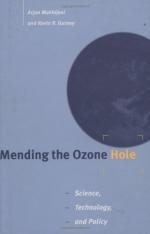|
This section contains 5,215 words (approx. 18 pages at 300 words per page) |

|
Earth's Protective Ozone Layer
Ozone is a gas naturally present in Earth's atmosphere. Unlike regular oxygen, which contains two oxygen atoms (O2), ozone contains three oxygen atoms (O3). A molecule of regular oxygen can be converted to ozone by ultraviolet (UV) radiation, electrical discharge (such as from lightning), or complex chemical reactions. These processes split apart the two oxygen atoms, which are then free to bind with other loose oxygen atoms to form ozone.
Ozone exists in Earth's atmosphere at two levels—the troposphere and the stratosphere. (See Figure 3.1.) Tropospheric (or ground-level) ozone accounts for only a small portion of Earth's total ozone, but it is a potent air pollutant with serious health consequences. Ground-level ozone is the primary component in smog and is formed via complex chemical reactions involving emissions of industrial chemicals and through...
|
This section contains 5,215 words (approx. 18 pages at 300 words per page) |

|


